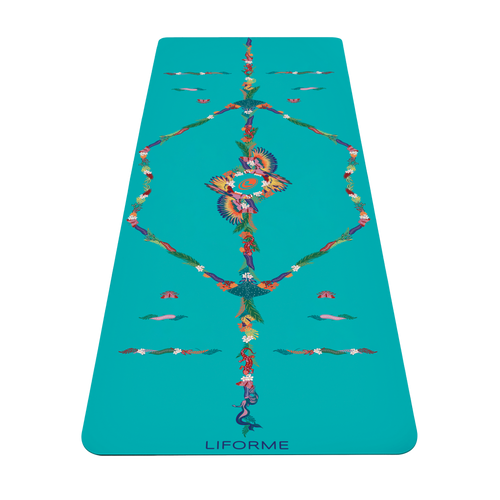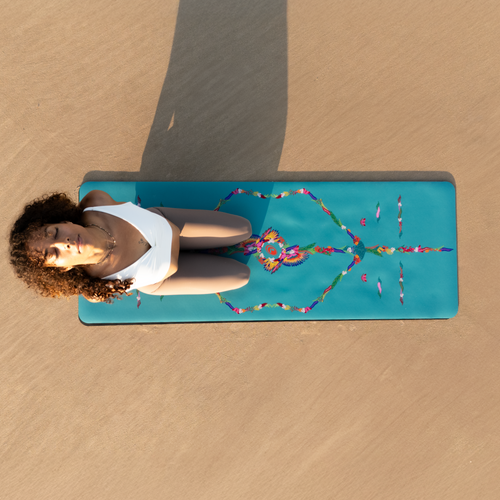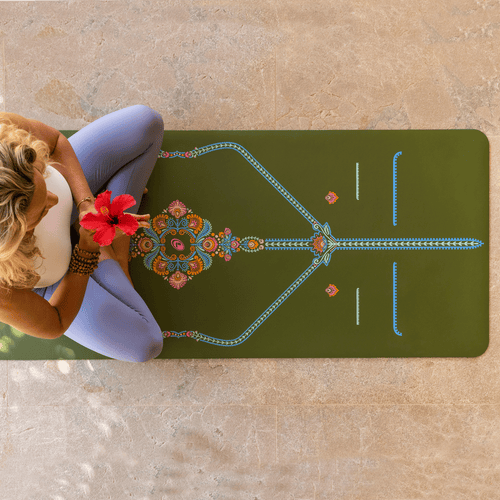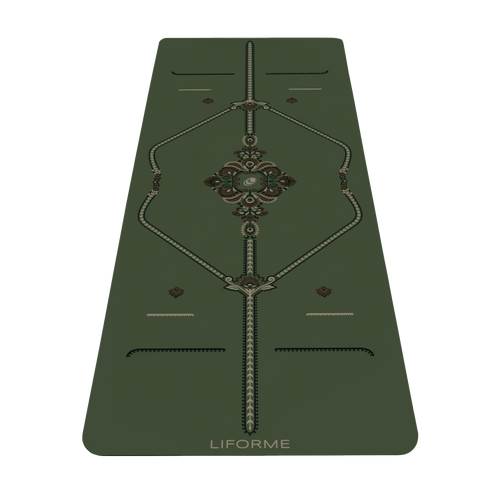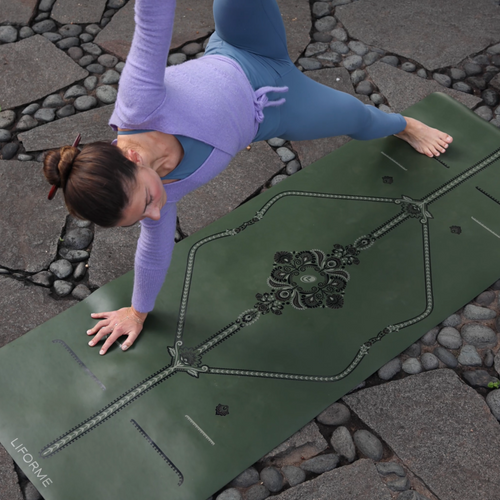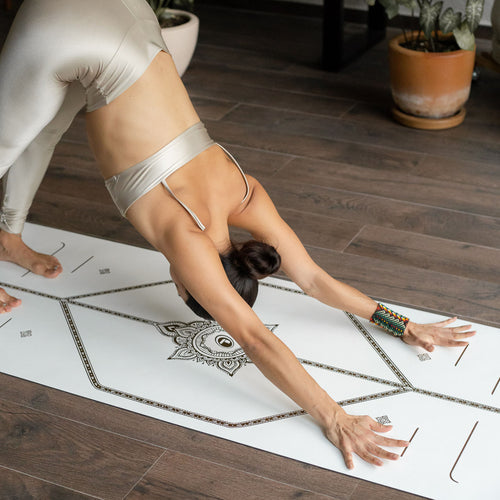Here, we’ll take a pelvis-oriented approach to three types of Cat-Cow movements: classic hands and knees, a seated chair version, and supine pelvic tilts.
Step-by-Step Instructions for Cat Cow Stretch
Hands-and-Knees Position
- Begin on your hands and knees. Spread your fingers and press down through your finger pads.
- Externally rotate your upper arms so that your elbow creases are facing forward. Look at the floor just in front of your hands to keep your neck in a neutral position.

Cow Pose (Bitilasana)
- Imagine your pelvis as a bowl full of water. On an inhalation, tip your pelvis forward so that the (imaginary) water pours out the front of the pelvic bowl.
- Lift your tail and flare your sit bones.
- Your abdomen will naturally curve toward the floor, but keep your belly button drawn in.
- Extend your neck as you look up toward the ceiling, creating a U-shaped curve from your tailbone to the neck.

Cat Pose (Marjaryasana)
- On your next exhalation, scoop your pelvis back under, stopping the (imaginary) water from pouring out.
- Tuck your tail and round your spine like an angry cat.
- Continue drawing in your belly button.
- Release your neck and bring your gaze towards your navel. This is a position of flexion for the spine that continues up through the neck.
Continue moving slowly back and forth between Cow and Cat on each inhalation and exhalation. Five to ten rounds usually works out the kinks and provides a nice warm-up.
🧘 Tips from a Yogi
Moving your spine regularly can make a huge difference in your mobility, which is a big factor in preventing back pain. A Cat-Cow a day keeps the doctor away!
Cat-Cow Basics
Sanskrit Meaning: Marjari (Cat) Asana (Pose) and Bitila (Cow) Asana (Pose)
Yoga Level: Beginner
Pose Type: Kneeling, gentle backbend
Pose Category: Spinal mobility, stretch
Also Known As: Chakravakasana
Benefits of Cat-Cow Stretches
- Promotes healthy spinal movement
- Tones the abdominal muscles
- Improves body awareness
- Combats the effects of sitting
- Warms up your back
Key Alignment Cues
1. Wrists Under Shoulders, Knees Under Hips
Make sure that your wrists are directly underneath your shoulders and your knees are directly underneath your hips. Many people tend to place the knees a little too far back. Stacking everything nice and square ensures that you’ll have a solid foundation to move from.
2. Initiate Movement from the Pelvis
Although we often describe Cat and Cow in terms of what the head, spine, and tailbone are doing, those movements originate from the position of the pelvis.
3. Draw Your Navel In
Keep your navel lightly drawn toward your spine throughout the sequence to engage the core and support your lower back.
Cat-Cow Variations
Seated Chair Cat-Cow Step-by-Step Instructions
Seated Cat-Cow works well in situations where you can’t get down on all fours due to injury, being on an aeroplane, or sitting at your desk at work, for instance. Your pelvis doesn’t have as much freedom of movement when you’re sitting, but you can still get some good movement in the spinal column.
Set-Up
- Start by placing both feet as flat on the floor as possible. You may need to adjust your chair or take off your shoes to create a stable, even seat.
- If your chair puts you in a position where your hips are below your knees, scoot forward so your knees and hips are as close to level as possible.
- Place your hands on your knees with your arms straight.
Seated Cow
- On an inhalation, tip your pelvis forward and feel that action take your lower back into spinal extension (a backbend).
- As the movement continues up your spine, blossom your chest through your shoulders, allowing your upper arms to roll out a bit.
- Lift your head to take your gaze gently to the ceiling. No need to throw your head back as that can crunch your neck.
Seated Cat
- On an exhalation, tuck your tail under, moving the pelvis to a posterior position.
- Round your spine, letting your shoulders roll forward as your chin drops to your chest.
- Move through several rounds of the stretch to counteract the effects of staring at a computer monitor for long hours.
Pelvic Tilts Step-by-Step Instructions
The pelvic tilt is a supine version of a Cat-Cow with an emphasis on (surprise!) the pelvis. This underrated exercise is actually great preparation for yoga asana practice and an awesome way to improve pelvic awareness while strengthening the muscles of your back and abdomen. Pelvic tilts are often prescribed by physical therapists for the prevention of back pain.
- Lie down on your back with your knees bent toward the ceiling and the soles of your feet flat on the floor. With your pelvis in a neutral position, the natural curve of the lumbar spine creates a small space between your lower spine and the floor.
- On an inhalation, press your sitting bones (the lower back side of the pelvis) into the mat to arch your lumbar spine away from the floor, emphasising its natural curve.
- On your next exhale, curve your pubis (lower front side of the pelvis) toward your face to flatten your low back to the mat, removing any space between your back and the floor.
That’s all there is to it! It’s a very subtle movement that doesn’t have to be big to be effective. Try to keep your movements small, concentrating on the back and forth of the pelvis. At no point do your hips leave the floor. Doing pelvic tilts also helps give you a better understanding of pelvic movement in Cat-Cow stretches in the all fours and seated positions.
Why We Practice Cat-Cow Stretches
Cat-Cow stretches remind us how breath and movement are deeply connected and how even the simplest flows can bring awareness, release tension and awaken the body.
Once you get going, it can feel good to take your Cat-Cows a little further. On your exhales, this might look like drawing your butt back to your heels and rounding your spine into a Child’s Pose with the knees together. On your inhales, try slithering your chest forward close to the mat in a Cobra-like movement. You might also circle or sway the hips. Take this opportunity to move intuitively and listen to what your body needs in the moment.
Cat-Cow FAQs
Can I do Cat-Cow if I have back pain?
Cat-Cow is generally safe for most people with mild back pain because it promotes gentle spinal movement and helps release stiffness. However, if you experience severe or chronic back pain, consult a healthcare professional before practicing.
What are the benefits of doing Cat-Cow stretches daily?
Practicing Cat-Cow daily can make a big difference in how your body feels. It gently wakes up your spine, helping it stay flexible and free from stiffness. You might notice tension easing out of your back and neck, and your core getting a little stronger. Plus, it’s a great way to break up long periods of sitting, inviting your body to move and breathe more easily throughout the day.
How long should I do the Cat-Cow Pose?
For most people, doing Cat-Cow stretches for about 5-10 rounds (roughly 1 to 2 minutes) is enough to gently warm up the spine and release tension. You can adjust the duration based on how your body feels; if you need more loosening or you are using it as a relaxing stretch, feel free to go longer.












